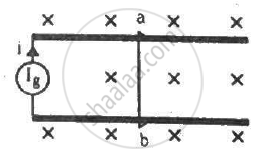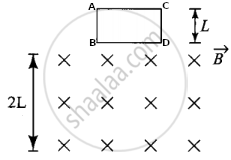Advertisements
Advertisements
प्रश्न
Two long straight parallel conductors carrying steady currents I1 and I2 are separated by a distance 'd'. Explain briefly, with the help of a suitable diagram, how the magnetic field due to one conductor acts on the other. Hence deduce the expression for the force acting between the two conductors. Mention the nature of this force.
उत्तर
Assumption: Current flows in the same direction.
Using Right hand thumb rule, the direction of the magnetic field at point P due to current I2 is perpendicular to the plane of paper and inwards.
Similarly, at point Q on X2Y2, the direction of magnetic field due to current I1 is perpendicularly outward.
Using Fleming’s left hand rule we can find the direction of forces F12 and F21 which are in opposite directions thus,
By Ampere’s circuited law, we have,

`B^2 =mu_0/(4pi) (2I_2)/d`
Now, F12 = I1LB2 (Where L ≡ length of the conductors)
`F_12 =(mu_0)/(4pi) (2I_1I_2L)/d =mu_0/(2pi)(I_1I_2L)/d`
In similar manner we get,
`F_21 =mu_0/(2pi) (I_1I_2L)/d .... (1)`
From above we get the magnitude of forces F12 and F21 are equal but in opposite direction. So,
F12 = −F21
Therefore, two parallel straight conductors carrying current in the same direction attract each other.
Similarly, we can prove if two parallel straight conductors carry currents in opposite direction, they repel each other with the same magnitude as equation (1).
संबंधित प्रश्न
Find the condition under which the charged particles moving with different speeds in the presence of electric and magnetic field vectors can be used to select charged particles of a particular speed.
A point charge q moving with speed v enters a uniform magnetic field B that is acting into the plane of the paper as shown. What is the path followed by the charge q and in which plane does it move?
Show with the help of a diagram how the force between the two conductors would change when the currents in them flow in the opposite directions?
The current generator Ig' shown in figure, sends a constant current i through the circuit. The wire ab has a length l and mass m and can slide on the smooth, horizontal rails connected to Ig. The entire system lies in a vertical magnetic field B. Find the velocity of the wire as a function of time.

A magnetic field that varies in magnitude from point to point but has a constant direction (east to west) is set up in a chamber. A charged particle enters the chamber and travels undeflected along a straight path with constant speed. What can you say about the initial velocity of the particle?
A charged particle moves through a magnetic field perpendicular to its direction. Then ______.
If an electron is moving with velocity `vecnu` produces a magnetic field `vec"B"`, then ______.
A circular coil of radius 10 cm is placed in a uniform magnetic field of 3.0 × 10-5 T with its plane perpendicular to the field initially. It is rotated at constant angular speed about an axis along the diameter of coil and perpendicular to magnetic field so that it undergoes half of rotation in 0.2 s. The maximum value of EMF induced (in µV) in the coil will be close to the integer ______.
A square coil ABCD with its plane vertical is released from rest in a horizontal uniform magnetic field `vec"B"` of length 2L. The acceleration of the coil is ______.

A conductor ABOCD moves along its bisector with a velocity 1 m/s through a perpendicular magnetic field of 1 wb/m2, as shown in figure. If all the four sides are 1 m length each, then the induced emf between A and Din approx is ______V.

